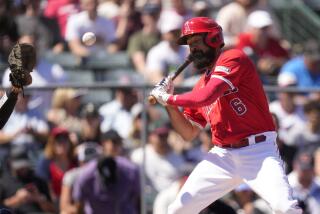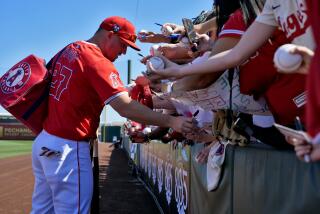Angels Need Him Down the Stretch
- Share via
TEMPE, Ariz. — It was Darin Erstad and his demons, alone on an empty highway in the middle of the night, pickup truck partners on a nonstop, 27-hour drive from Orange County to Fargo, N.D., on Sept. 28, the day after a frustrating 1998 season had ended.
“I remember being in the middle of Utah about midnight,” said Erstad, cut down by hamstring injuries in the last two months of 1998. “The next thing I knew, it was morning and I was in Butte, Montana. I just kept playing it over and over in my head. To come that close and not be able to help the team . . . that was tough to accept.”
Mile after mile, the questions haunted Erstad, whose 1997 season was also cut short because of a sore shoulder. Was he injury prone? Could he have prevented these setbacks with a different conditioning regimen? Does he play so hard that he simply wears himself out?
And the prize puzzler: Would the Angels have held off the Texas Rangers and won the American League West title with a sound Erstad, the one whose most-valuable-player candidacy gained steam during a prolific first half, instead of the hobbled Erstad, who was limited to 20 September at-bats as the Angels faded down the stretch for the second consecutive year?
There’s really no answer to the last question, but Erstad was able to sort out some other issues during his winter of rehabilitation and reflection.
In replaying his second hamstring injury, which occurred as he approached first base on what appeared to be a sure double leading off a game in Cleveland on Sept. 2, he keeps going back to that pregame stretch in Jacobs Field.
The Angels had just come off a grueling, five-game series in New York, having won three games over the Yankees. They were in first place with a 2 1/2-game lead over Texas, and Erstad, who had been on the disabled list in August because of a hamstring strain, felt invigorated.
“I remember telling [former strength and conditioning coach] Tom Wilson that I couldn’t believe how good I felt,” Erstad, 24, said. “I was fresh. My legs felt great. People say you break down, your muscles are weak, you’re tired, but I felt great. That’s why that injury was so hard to understand. It was something I had no control over.”
Nor does Erstad have much control over the highly aggressive, borderline reckless way he plays. He dives for every ball within reach and is a terror on the basepaths.
But wouldn’t Erstad benefit from easing back on that throttle just a bit on occasion?
“I’ve only played one way my entire life, and I can’t see changing,” he said. “If I can’t play how I want to play, if my body can’t handle it, I should do something else.
“If I don’t play as hard as I can, I would be disrespecting the game and cheating myself, and I can’t do that.”
Erstad has a .295 average with 78 doubles, 39 homers and 179 runs batted in 2 1/2 seasons with the Angels. He is moving from first base to the outfield this season and plans one other major change as well: He will incorporate more hamstring-strengthening exercises.
A winter test revealed that Erstad’s thigh muscles were almost as strong as those of former NFL lineman Anthony Munoz. His hamstrings, however, were about as strong as those of an average high school athlete.
“It was really an eye-opener,” Erstad said. “I’ve got to even out those ratios a bit.”
Erstad’s 1998 production figures were a bit out of whack too.
He hit .313 with 18 home runs, 28 doubles and 59 RBIs in the first half, earning a trip to the All-Star game and the praise of several opposing managers who dubbed him one of baseball’s brightest new stars.
Erstad’s second-half stats: a .260 average, one home run and 23 RBIs.
The original hamstring injury sent him to the disabled list Aug. 10, but there was an entire month after the All-Star game when Erstad was fit and still hit only one homer, so he couldn’t use injury as the sole excuse.
“I learned that it’s a long season, and things even out after the first half,” he said. “I’ve never hit home runs at that pace--I’ve never really been a home run hitter. I’m more of a line-drive hitter. A lot of my line drives just carried over the fence.
“I didn’t really change my approach much in the second half. I got pitched a little differently.”
Actually, pitchers completely changed their approach in July, giving Erstad fewer high fastballs, which he had feasted on, and fewer pitches on the outer half of the plate, which he usually handled with ease, choosing instead to bust him low and inside.
Right-handers who could get a hard slider to break inside, either at Erstad’s hands or below his thighs, had success against the left-handed hitter.
And Erstad knows it.
“You have to learn to adjust and to not swing at those pitches,” he said. “I had some success in the first half and wasn’t seeing the same pitches after the All-Star break. I tried to do too much and swung at pitches out of the strike zone. Once you start doing that, you’re in trouble.”
Although much of Erstad’s winter rehab was for his hamstring, his conditioning program was not limited to the physical. He also tried to envision his adjustment to the pitchers who made adjustments to him last summer.
“I’ve got to learn to lay off those pitches, or, if they’re strikes, how to hit them,” he said. “I have a natural downward swing, and that has helped me get to the high fastball. I have to learn what my hot spots are and to focus on pitches in those areas.”
More to Read
Go beyond the scoreboard
Get the latest on L.A.'s teams in the daily Sports Report newsletter.
You may occasionally receive promotional content from the Los Angeles Times.







